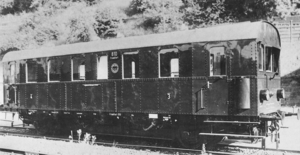DR 807 to 811
| DR 807-811 | |
|---|---|
|
807-811
|
|
| Numbering: | DRG : 807-811 |
| Number: | 5 |
| Manufacturer: | Wegmann Kassel |
| Year of construction (s): | 1929 |
| Retirement: | Mid 1930s |
| Type : | AA dm |
| Genre : | BCvT |
| Gauge : | 1435 mm ( standard gauge ) |
| Length over buffers: | 12,996 mm |
| Length: | 11,800 mm |
| Height: | 3,820 mm |
| Width: | 3,100 mm |
| Total wheelbase: | 7,000 mm |
| Service mass: | empty: 33,700 kg occupied: 38,580 kg |
| Top speed: | 70 km / h |
| Installed capacity: | 2 × 55 kW (2 × 75 PS) |
| Wheel diameter: | 1,000 mm |
| Motor type: | 2 × MAN W6V 11 (18) |
| Motor type: | Six-cylinder four-stroke diesel engine |
| Rated speed: | 1,100 rpm |
| Power transmission: | mechanical with 2 Soden gears |
| Tank capacity: | 300 l |
| Brake: | Compressed air brake type Knorr |
| Seats: | 2nd class 12 3rd class 31 |
| Standing room: | 22nd |
| Floor height: | 1,420 mm |
| Classes : | 2nd / 3rd |
The DRG 807-811 were a late 1920s developed railcars - series of the German Railway Company for the passenger on branch lines . They can be described as a reinforced version of the 801–804 with a double machine system. The vehicles were not in service for long and have been considered retired for use in passenger transport since the mid-1930s.
history
These vehicles were ordered by the Deutsche Reichsbahn in 1926 as high-performance railcars, the drive power of them was doubled compared to the 801 to 804 thanks to the twin engine system . Due to the heavy wagon construction and the double machine system, however, part of the additional power was used up again, so that the specific power compared to the 801 to 804 rose only insignificantly from 2.14 kW / t to 2.85 kW / t.
Since they could not compete with the lightweight railcars, they were considered to be retired as railcars for passenger transport as early as the mid-1930s. In addition, there was the mechanical drive system with the Soden transmission , which was unsatisfactory in other first-generation vehicles. After they were taken out of service as a railcar, their machinery was expanded. The 810 was assigned to the Reichsbahndirektion Frankfurt / Main .
In 1948 the 811 was taken out of service as the last vehicle in the series; it was converted by the Wehrmacht into a three-axle armored vehicle with electrical power transmission . The heavier machine equipment made the three-axle wagon necessary.
Constructive features
The car body was a construction of a passenger car with a barrel roof , to which only the access doors at the pointed ends of the vehicle were moved to the rear due to the locomotive driver's cab. The wheel sets were guided in roller bearings and designed as steering axles . The interior consisted of an open- plan compartment of the 3rd class and a double compartment of the 2nd class between the entry / driver's cabins.
The double machine system hung in mirror image in a support frame under the car body. One machine system consisted of a six-cylinder four-stroke diesel engine from MAN and a gearbox of the Soden type. The drive wheel sets were driven by cardan shafts and gear set reversing gears. The power adjustment of the diesel engine was done mechanically. The gear preselection of the transmission was done mechanically via a locking roller, the clutch and shift process was a purely pneumatic matter,
literature
- Heinz R. Kurz: The railcars of the Reichsbahn-Bauarten , EK-Verlag, Freiburg 1988, ISBN 3-88255-803-2 .
Web links
- Description of the railcars from the Reichsbahn era on reichsbahntriebwagen.de
Individual evidence
- ↑ Heinz R. Kurz: The railcars of the Reichsbahn types , EK-Verlag, Freiburg 1988, ISBN 3-88255-803-2 , page 99
- ↑ a b c d Heinz R. Kurz: The railcars of the Reichsbahn-Bauarten , EK-Verlag, Freiburg 1988, ISBN 3-88255-803-2 , page 100
